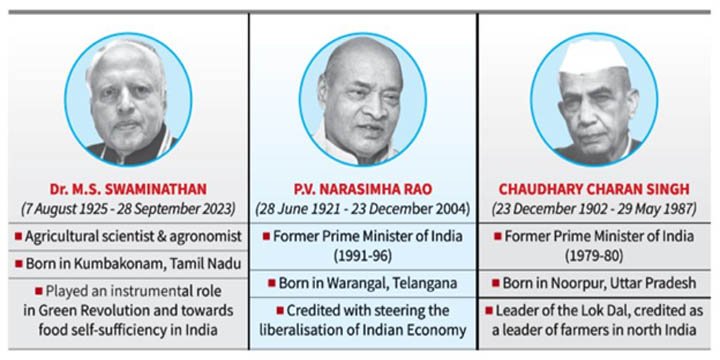Bharat Ratna for PV Narasimha Rao: How he almost quit politics, then became Prime Minister
Context- Former Prime Ministers PV Narasimha Rao and Chaudhary Charan Singh, along with agricultural scientist MS Swaminathan, are set to receive the Bharat Ratna, India’s highest civilian award.
Narasimha Rao’s tenure as Prime Minister was highlighted for significant measures that opened India to global markets, fostering a new era of economic development. His contributions to India’s foreign policy, language, and education sectors underscore his multifaceted legacy as a leader who steered India through critical transformations and enriched its cultural and intellectual heritage.
Interestingly, just a year before he became the PM, Rao had thought his political career was almost over. He had even considered becoming the head monk at a monastery in Tamil Nadu. However, circumstances changed, and Rao first became the Congress chief and then the prime minister.
On the verge of exit
- In 1990, PV Narasimha Rao learned that Rajiv Gandhi, the then Congress chief, intended to transition to a younger Cabinet if the party won the next year’s Lok Sabha elections.
- This information, coupled with Rao’s own fatigue with politics, led him to start planning his post-retirement life. However, the assassination of Rajiv Gandhi on May 21, 1991, at a campaign stop in Sriperumbudur, Tamil Nadu, dramatically altered the trajectory of Rao’s political career.
The come back
- After learning of Rajiv Gandhi’s death, PV Narasimha Rao attended the funeral at 10 Janpath. There, Pranab Mukherjee, a senior Congress leader, informed him of a consensus for Rao to become the next Congress President. Despite his happiness, Rao kept his emotions under wraps.
- In his book, Sitapati noted Rao’s caution, recalling how Mukherjee had prematurely claimed succession after Indira Gandhi’s death seven years prior and was subsequently sidelined.
- Several other leaders, including Arjun Singh, ND Tiwari, Sharad Pawar, and Madhav Rao Scindia, were also contenders for the party presidency.
- Sonia Gandhi, tasked with choosing the successor, was familiar with all the candidates. However, each had their drawbacks.
- For instance, Sharad Pawar had previously split the state unit to become CM in 1978, and ND Tiwari had disobeyed Rajiv Gandhi’s instructions and contested the ongoing Lok Sabha elections, which he lost.
- Rao emerged as the preferred choice for the next Congress President, thanks to the strong support he received from President R Venkataraman and a significant number of Congress MPs from peninsular India.
- Sanjay Baru, noted that Rao was among the most experienced Congress leaders at the time, having served as a state CM, party general secretary, and Union minister for multiple portfolios.
- PN Haksar, Indira Gandhi’s former principal secretary, also recommended Rao for the presidency, citing his intellectual prowess and ability to maintain party unity.
- On May 29, 1991, Rao was elected the Congress President, and the following month, after the party won 232 of 487 seats in the national elections, he became the Prime Minister.
PV Narasimha Rao, the 9th Prime Minister of India, made significant contributions to the country’s economic and political landscape:
- Economic Reforms: Rao is often referred to as the ‘Father of Indian Economic Reforms. In 1991, during a severe economic crisis, his government initiated sweeping liberalization measures. These reforms aimed at dismantling the restrictive License Raj and opening India’s economy to foreign investment. His program involved cutting government regulations and red tape, abandoning subsidies and fixed prices, and privatizing state-run industries.
- Foreign Policy: Rao’s tenure saw significant transformations in India’s foreign policy. He steered India through critical global transformations, enriching its international relations.
- Facilitating India’s Nuclear Programme: Rao played a crucial role in facilitating India’s nuclear programme.
- Ending Insurgencies in Punjab: Rao’s leadership was instrumental in ending insurgencies in Punjab.
- Leadership Roles: Rao served in various capacities including Chief Minister of Andhra Pradesh, Union Minister, and as a Member of Parliament and Legislative Assembly for many years. He had been a Union minister for external affairs, defence, home and human resources development.
- Intellectual Contributions: Rao was an intellectual who enriched India’s cultural and intellectual heritage. His visionary leadership laid a solid foundation for the country’s prosperity and growth
Conclusion –The journey of PV Narasimha Rao from contemplating retirement to becoming the President of the Congress party and subsequently the Prime Minister of India is a testament to his resilience and political acumen. Despite the intense competition and various challenges within the party, Rao’s experience, intellectual prowess, and ability to maintain unity made him the preferred choice for leadership. His tenure as Prime Minister marked significant transformations in India’s economic and foreign policy landscape.


